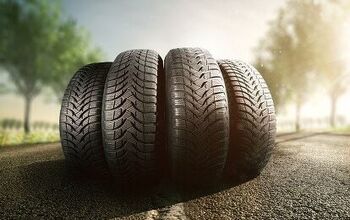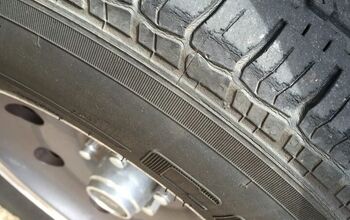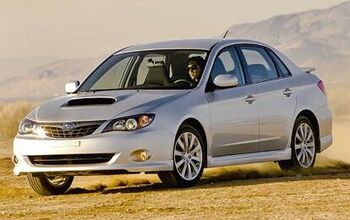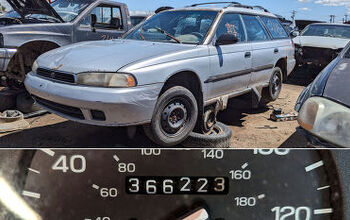Piston Slap: "Spare" Me From Dry Rot!

TTAC Commentator sastexan writes:
With the extreme cold throughout the US and seeing a few shredded tires on the highway this week (in fact, I had a flat myself – not sure what caused it but possibly doing donuts in the FR-S on a parking lot last week with lots of broken up ice on the edges), I got to thinking about spare tires.
Many of the Best and Brightest have “keeper” cars – myself included with our old Camry. Tires have limited lifespans due to dry rot, and I’m guessing spare tires are included in that category. The spare in the Camry is the original 14 year old tire (full size spare at least). How often do people change their spares, if ever? Has anyone with an aged spare had it blow out due to dry rot? Can you just order a new space saver spare off of tire rack?
Take care,
Steven
Sajeev answers:
Very interesting question, one that raises even more questions! Keep these in mind before we proceed:
- Tires dry rot slower when living in an enclosed space with no exposure to sunlight (UV rays).
- You may not see visible cracks like other rotted tires, but rest assured at some point the rubber has petrified like a rock.
- The odds of getting stranded by a rotted temporary spare is less likely than an ordinary tire, as nobody wants to roll around on that tiny donut for an extended period.
- Low air pressure can be the reason for a spare blow out, as they tend to leak profusely after a few years of hibernating in a trunk.
- The items listed above will not necessarily apply to externally mounted spares in trucks/SUVs/CUVs. Treat those more like your other four wheels.
Externally mounted full size spare owners: change the tire every 5-10 years…more or less, depending on your risk tolerance and driving needs. Or re-use one of your “old” tires as a spare when upgrading to new ones for your regular wheels. And if you are luckily to have a matching 5th wheel as a spare (or unlucky enough to have 5 steel wheels on your ride) just rotate it into the mix.
Externally mounted temporary spare owners? Good question, as this is a future quandary of my little Ranger pick-em-up truck. Then again, it might be similar to our next case…
Internally mounted spare owners? Who knows the safe lifespan, but I’d wager that 10+ years is fine, since I’ve used the original spare in my Mark VIII for short distances in urban conditions. I’d change my tune if I was traveling hundreds of miles daily on rural roads…grabbing spare tires from crusher-bound Taurii and Fusions in the process.
Whenever you “internally mounted spare” folks are ready for new rubber, well yes, Tire Rack sells spares…but I’ll assume China’s finest off-brand donuts trade for less money from another vendor, as that happened when my 1983 Ford Sierra needed new tires in it’s unobtanium space saver-esque size for a measly $34 a pop. Which is more than adequate for the job.
In the case of your Camry? I say replace it (full size spare in the trunk) with one of the external tires when its time for new shoes. Or get a used tire from any local shop for $20-ish. Or just make sure it’s inflated to spec and you drive SLOW (i.e. 50mph or less) for a short period of time. There’s no wrong answer here, unless you’re stranded in the middle of no where and must rely on a fresh tire to take you hundreds of miles away in a harsh climate.
As with everything in life, this Piston Slap boils down to: It depends.
So eyeball the rubber and keep it inflated to spec. That’s a good start. Off to you, Best and Brightest.
Send your queries to sajeev@thetruthaboutcars.com. Spare no details and ask for a speedy resolution if you’re in a hurry…but be realistic, and use your make/model specific forums instead of TTAC for more timely advice.
[Image: Shutterstock user Wachira W.]

More by Sajeev Mehta
Latest Car Reviews
Read moreLatest Product Reviews
Read moreRecent Comments
- Plaincraig 1975 Mercury Cougar with the 460 four barrel. My dad bought it new and removed all the pollution control stuff and did a lot of upgrades to the engine (450hp). I got to use it from 1986 to 1991 when I got my Eclipse GSX. The payments and insurance for a 3000GT were going to be too much. No tickets no accidents so far in my many years and miles.My sister learned on a 76 LTD with the 350 two barrel then a Ford Escort but she has tickets (speeding but she has contacts so they get dismissed or fine and no points) and accidents (none her fault)
- Namesakeone If I were the parent of a teenage daughter, I would want her in an H1 Hummer. It would be big enough to protect her in a crash, too big for her to afford the fuel (and thus keep her home), big enough to intimidate her in a parallel-parking situation (and thus keep her home), and the transmission tunnel would prevent backseat sex.If I were the parent of a teenage son, I would want him to have, for his first wheeled transportation...a ride-on lawnmower. For obvious reasons.
- ToolGuy If I were a teen under the tutelage of one of the B&B, I think it would make perfect sense to jump straight into one of those "forever cars"... see then I could drive it forever and not have to worry about ever replacing it. This plan seems flawless, doesn't it?
- Rover Sig A short cab pickup truck, F150 or C/K-1500 or Ram, preferably a 6 cyl. These have no room for more than one or two passengers (USAA stats show biggest factor in teenage accidents is a vehicle full of kids) and no back seat (common sense tells you what back seats are used for). In a full-size pickup truck, the inevitable teenage accident is more survivable. Second choice would be an old full-size car, but these have all but disappeared from the used car lots. The "cute small car" is a death trap.
- W Conrad Sure every technology has some environmental impact, but those stuck in fossil fuel land are just not seeing the future of EV's makes sense. Rather than making EV's even better, these automakers are sticking with what they know. It will mean their end.


































Comments
Join the conversation
A number of years ago I spent a couple of months in Indonesia on business. I came to realize that the standard for replacing tires there was when the tread had worn completely through to the cords. Tires are amazing structures that require substantial abuse to make them fail, in most cases. Track use is not comparable to every day driving for the stresses placed on tires. Most people are unwilling or unable to use the full acceleration, cornering or braking capability of their cars, even in emergency situations. So they can get away with poor tires and not notice anything. Inflation pressure is a controversial subject. The carmakers pressure recommendations should be viewed as minimum. On my Saab, that is stated so on the sticker, with higher pressures set for increased load and speeds. The tires sidewall pressure states the maximum. Yes, it produces a rougher ride at higher pressures. But load capability and handling are improved and rolling resistance is reduced. Hydroplaning speed is increased with higher pressure. I had the original tires on my 1972 Centurion bicycle until last year. The "gumwall" sidewalls had long crumbled to nothing. But the tread remained OK until the very end. That was 40 years. So I think perhaps the answer to the age discussion may lie in the fact that synthetic rubber does age, oxidize, and harden through UV exposure, but the rate depends on the quality of the rubber and the exposure history. If the rubber is hard and resistant to indentation, then don't use the tire.
One thing I've not seen mentioned in this thread is steel belt deterioration. I've had it happen with two sets of tires. The belt breaks, the tread gets distorted and it feels like a terrible case of imbalance. A frequent recommendation is not to use steel belted tires (most of them nowadays) beyond six years from date of manufacture i.e. not date of installation. Big problem with "collectible" cars, not so much daily drivers.